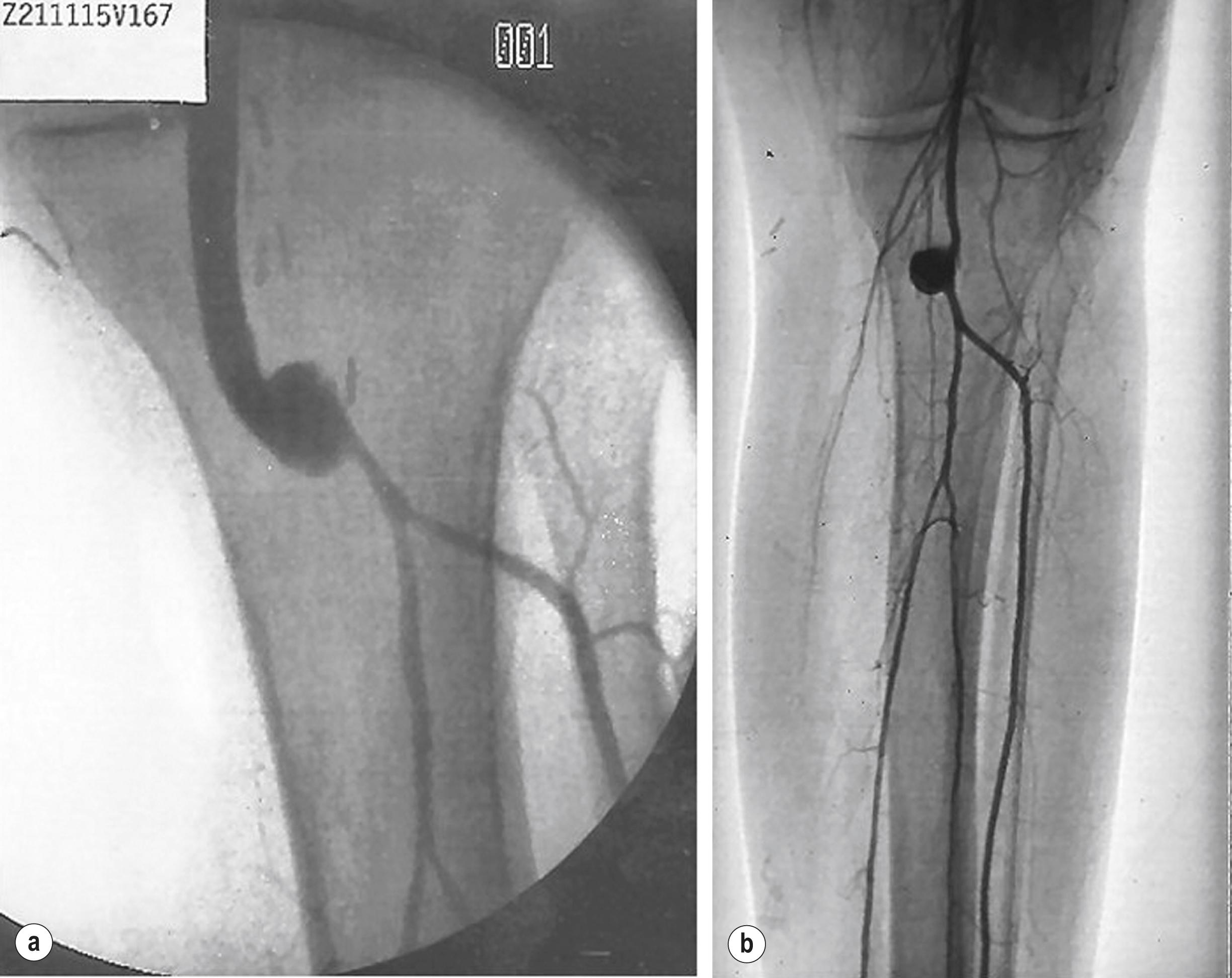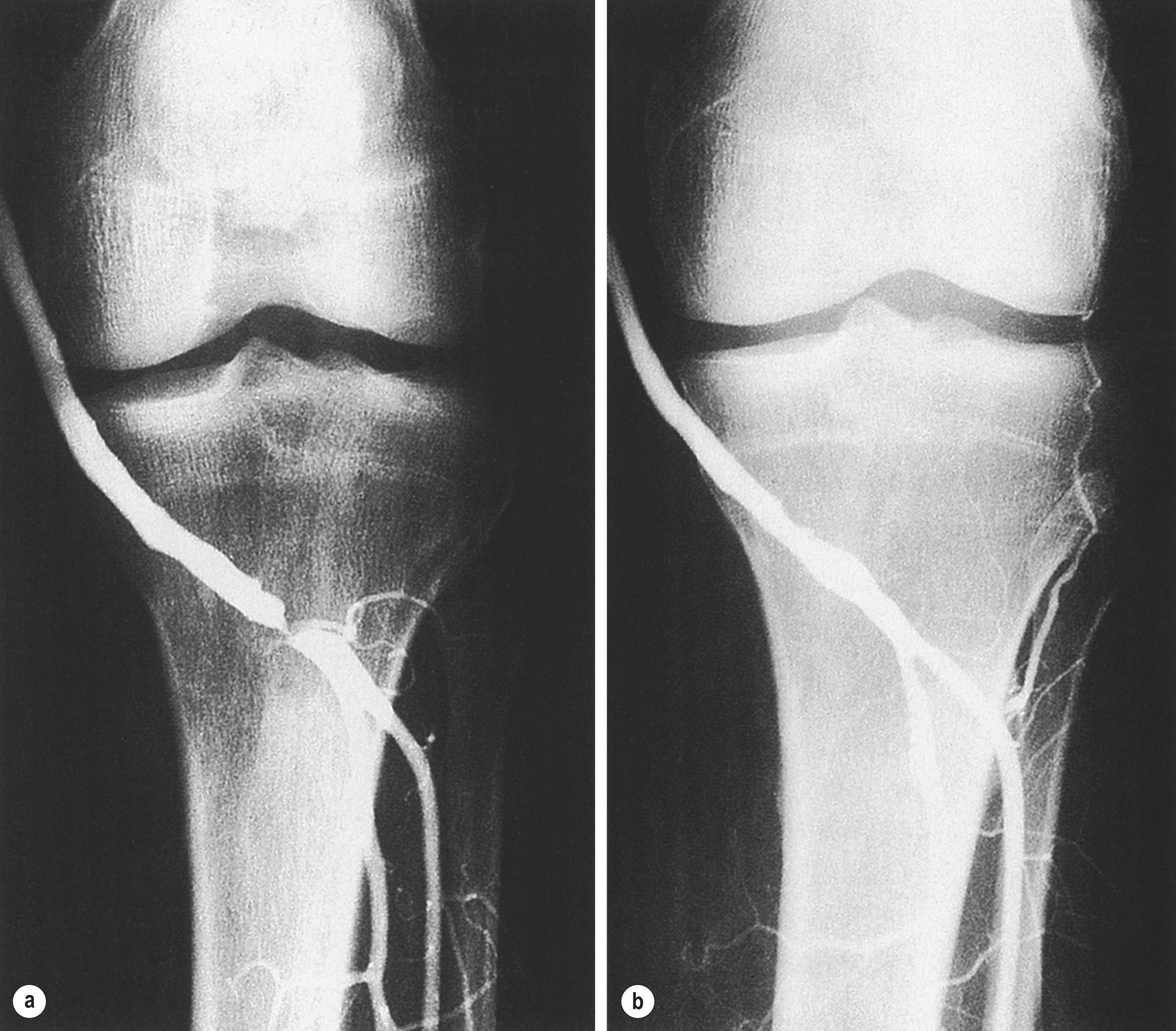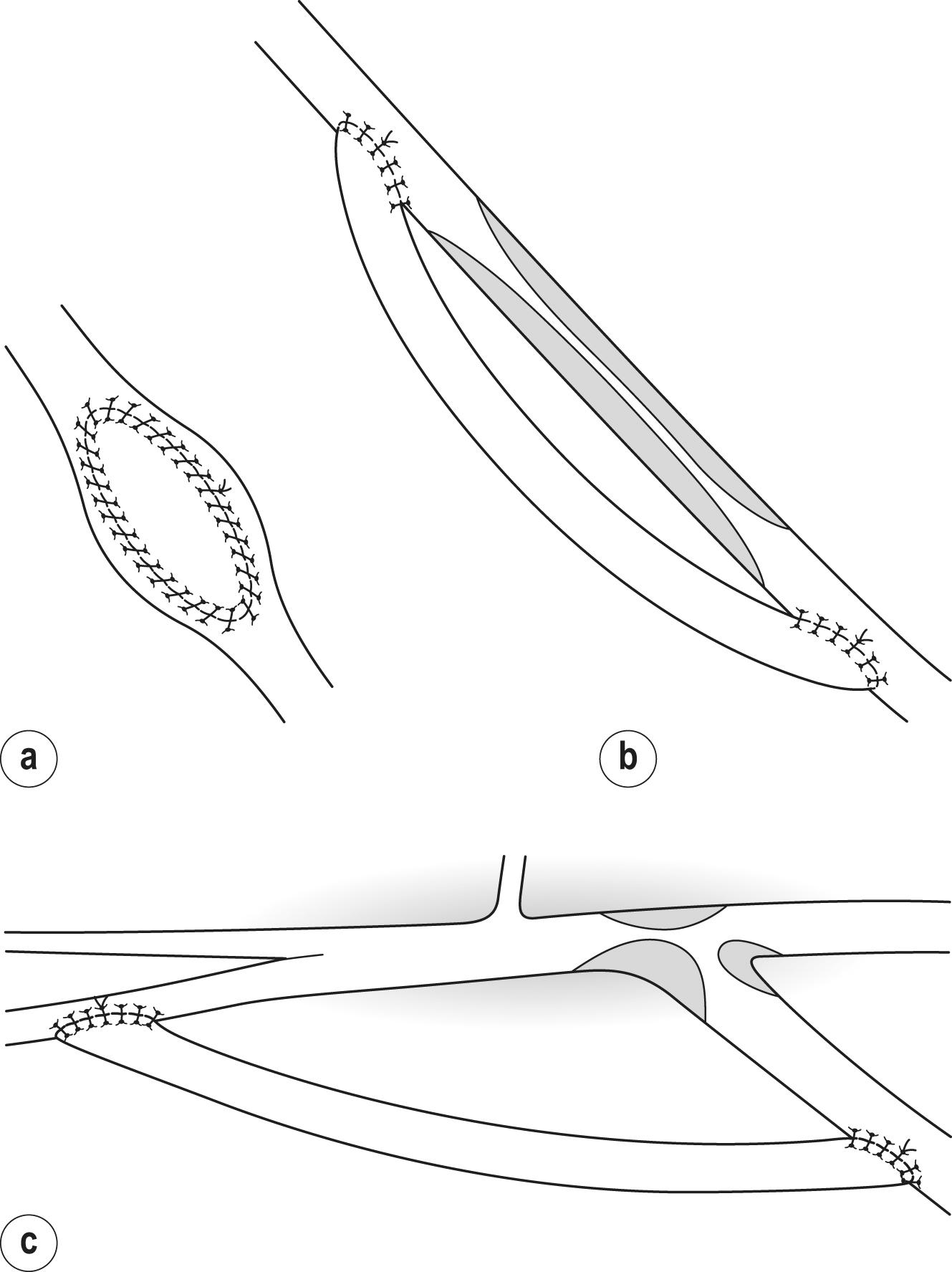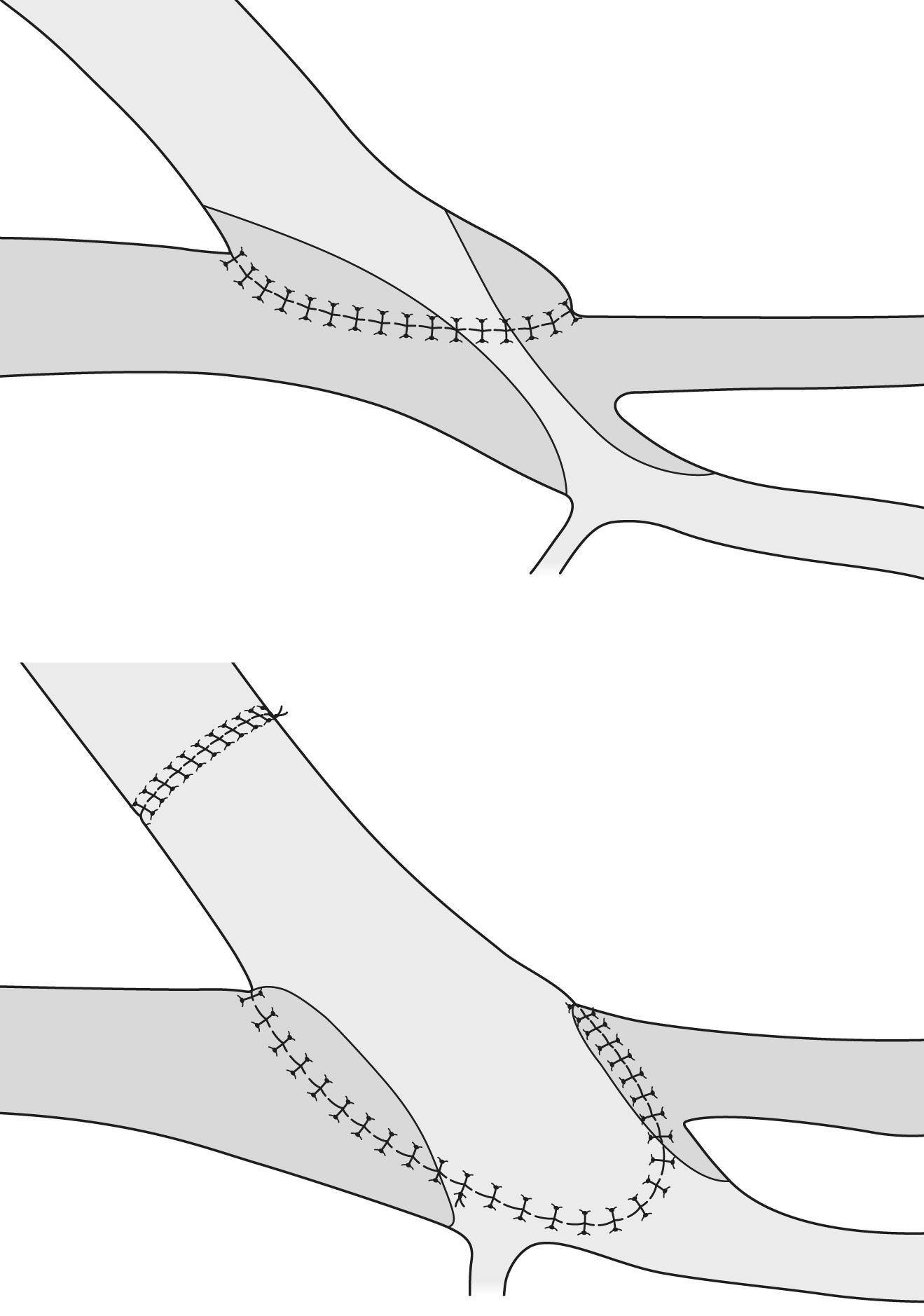Physical Address
304 North Cardinal St.
Dorchester Center, MA 02124
Revision of vascular reconstructions and interventions is frequently required beyond the first 6 weeks because of progressive atherosclerosis, graft occlusion , aneurysm formation or infection . Up to 40% of femorodistal bypass surgery grafts require re-intervention within 5 years. The same is true for endovascular intervention where it has been shown that up to 30% of the patients need a re-intervention within 5 years after endovascular aortic aneurysm reconstruction (EVAR). Revision surgery requires experience and judgment; it is technically more difficult because of fibrosis and the loss of easily definable tissue planes, which necessitates careful sharp dissection to gain arterial control. The anatomy might be altered by previous operations or interventions and operating times, blood loss, infection rates and operative risk are therefore increased.
Graft thrombosis usually presents acutely but is occasionally foreshown by increasing ischaemic symptoms, ranging from mild claudication to critical ischaemia. Nevertheless, asymptomatic graft occlusion can also occur. Occasionally, simultaneous distal embolisation causes digital ischaemia (blue toe syndrome or gangrene). Graft thrombosis with loss of runoff caused by distal embolisation is associated with a high risk of limb loss. Whereas graft thrombosis in the first 6 weeks is generally caused by technical error or poor run-off, most late occlusions result from intimal hyperplasia within the bypass or progressive inflow or run-off disease (see Chapter 4 ). Graft stenoses are usually asymptomatic and occur in 20–30% of infra-inguinal vein grafts, mostly in the first year. , Stenoses of greater than 70% (velocity >3 m/s or velocity ratio >3.0) compromise flow and often occlude if left untreated.
These are essentially for the quality of the inflow, the run-off and the conduit itself (see Chapter 4 ).
Patency is better for supra-inguinal than infra-inguinal grafts and graft occlusion is more frequent in femorotibial than in femoropopliteal bypasses.
Infra-inguinal bypass patency of autologous vein is better than Dacron, polytetrafluoroethylene (PTFE) or human umbilical vein. Dacron and PTFE used in femoropopliteal bypass grafting did not differ in mid-term graft patency at 5 years. The 1-year-results of a Scandinavian multicentre randomised trial revealed that a Heparin-bonded PTFE (Hb-PTFE) graft significantly reduced the overall risk of primary graft failure by 37%. Risk reduction was 50% in femoropopliteal bypass cases and in cases with critical ischaemia. But at the 5-year results there was no difference in primary graft patency between Hb-PTFE and standard PTFE grafts. Patients receiving Hb-PTFE grafts for critical limb ischaemia were more likely to have a patent graft at 5 years than those with standard PTFE grafts.
The results of reversed and in situ vein grafts are equivalent. , In a meta-analysis on the long-term primary and secondary patency and foot preservation following popliteal-to-distal bypass grafts, there was a superiority trend favouring reversed vein grafts. (SCALPEL)
Arm veins are similar to long saphenous vein provided that angioscopically detected defects are corrected. Pre-operative ultrasound mapping seems to be crucial to use the best autogenous conduit available. A recent published retrospective study of infra-inguinal bypasses for critical limb ischaemia (CLI) using arm vein conduit or prosthetic grafts revealed that arm vein conduits, even when spliced, are superior to prosthetic grafts in terms of mid-term assisted primary patency, secondary patency, and leg salvage in infra-popliteal bypasses for CLI.
![]() A recent published Cochrane Review disclosed a clear primary patency benefit for autologous vein when compared to synthetic materials for above knee bypasses. In the long term (5 years), Dacron confers a small primary patency benefit over PTFE for above knee bypass. PTFE with a vein cuff improved primary patency when compared to PTFE alone for below knee bypasses. (SCALPEL)
A recent published Cochrane Review disclosed a clear primary patency benefit for autologous vein when compared to synthetic materials for above knee bypasses. In the long term (5 years), Dacron confers a small primary patency benefit over PTFE for above knee bypass. PTFE with a vein cuff improved primary patency when compared to PTFE alone for below knee bypasses. (SCALPEL)
The risk for ischemic complications and the need for emergency limb revascularisation are greater with occlusion of prosthetic grafts compared to venous grafts. This is because the thrombus in the prosthetic graft extends into the outflow artery. Vein cuffs at the distal anastomosis reduce the risk of outflow impairment after thrombosis of PTFE grafts ( Fig. 7.1 ).
The Dutch BOA Study found no difference between venous and prosthetic graft material in the risk of amputation after infra-inguinal bypass occlusion. (SCALPEL)

The quality and number of run-off vessels appear to potentially identify patients at high risk for a poor initial outcome by predicting patency in infra-inguinal bypass reconstructions. , Bypasses for gangrene occlude more frequently than for ulceration, rest pain or claudication. This is probably related to the poorer run-off associated with worsening ischaemia.
![]() Continued smoking after lower limb bypass surgery results at least in a threefold increased risk of graft failure. Diabetes and renal failure compromise patient survival but not graft patency. (PEN NIB)
Continued smoking after lower limb bypass surgery results at least in a threefold increased risk of graft failure. Diabetes and renal failure compromise patient survival but not graft patency. (PEN NIB)
Raised fibrinogen, hyperlipidaemia, thrombophilias (e.g., protein C, protein S or antithrombin III deficiency, antiphospholipid antibodies), and increased platelet aggregation favour graft thrombosis, whereas factor V Leiden mutation is debatable. ,
Black race and female sex are risk factors for adverse outcomes after vein bypass surgery for limb salvage, with graft failure and limb loss being more common events in Black patients, and Black women being a particularly high-risk group. (PEN NIB)
Even White women have more graft occlusions and recurrent stenoses and hormone replacement therapy potentiates this. ,
Antiplatelet therapy with aspirin had a slight beneficial effect on the patency of peripheral bypass grafts but seemed to have an inferior effect on venous graft patency compared with artificial grafts. The Dutch BOA trial revealed that aspirin is more effective for infra-inguinal prosthetic grafts, whereas warfarin is better for vein grafts.
In the CASPAR trial, the combination of clopidogrel plus aspirin did not improve limb or systemic outcomes in the overall population of peripheral artery disease patients requiring below-knee bypass grafting. A subgroup analysis suggested that clopidogrel plus aspirin awards benefit in patients receiving prosthetic grafts without significantly increasing major bleeding risk. (SCALPEL)
Surveillance for supra-inguinal bypass grafts does not seem to be cost effective. Occlusion is far more frequent after infra-inguinal bypass grafting and since most of the occlusions occur within 2 years after the implantation, patients should be carefully followed during this time period. This includes medical history, clinical examination and Doppler pressure measurements. Additional duplex scanning seems to not be effective after prosthetic bypass.
![]() Some published reports tend to argue in favour of duplex surveillance on the basis of patency alone. In a randomised trial with 596 patients, intensive surveillance with duplex scanning did not show any additional benefit in terms of limb salvage rates for patients undergoing femoropopliteal or femorocrural vein bypass graft operations. (SCALPEL)
Some published reports tend to argue in favour of duplex surveillance on the basis of patency alone. In a randomised trial with 596 patients, intensive surveillance with duplex scanning did not show any additional benefit in terms of limb salvage rates for patients undergoing femoropopliteal or femorocrural vein bypass graft operations. (SCALPEL)
Although there is some discussion about asymptomatic stenosis, it is clear that symptomatic graft stenosis should be treated by either angioplasty or surgical revision. Open surgical revision of femorodistal vein grafts provided an increased freedom from further re-interventions or major amputation; however, early success rates for endovascular procedures were similar, particularly for non-occluded grafts. And percutaneous transluminal angioplasty (PTA) of infra-inguinal vein grafts is safe and effective in the treatment of failing grafts. Graft angioplasties do not lose effectiveness when repeated and have shown cumulative benefit in prolonging graft survival. With time, endovascular revisions required an increasing number of re-interventions and manifested higher rates of failure. Surgical revision is probably more durable long term, but an endovascular approach is actually preferred because of the acceptable short-term patency and a low rate of complications, particularly for late graft stenosis (>3 months), short (<2 cm) and single stenoses.
Short graft stenosis, whether mid-graft or anastomotic commonly responds well to angioplasty with high inflation pressures (up to 2020 kPa) ( Fig. 7.2 ). Cutting balloons have been advocated, but seem to offer only small benefit at the expense of an elevated complication rate. Stents (preferably self-expandable bare nitinol) should be used only selectively.
A currently published randomised clinical study demonstrated that implantation of a polymer-free, paclitaxel-coated nitinol drug-eluting stent (DES) in patients with moderate-length lesions of the superficial femoral artery (SFA) and proximal popliteal artery was safe and associated with a superior 12-month patency compared with both PTA and provisional bare metal stent (BMS) placement. The proportion of treated re-stenosis in both cohorts was only 5.5 resp. 5.9%. Two-year and the 5-year outcomes with the paclitaxel-eluting stent support its sustained safety and effectiveness in patients with femoropopliteal artery disease, including the long-term superiority of the DES to PTA and to provisional BMS placement. , (SCALPEL)

Longer graft stenoses are best treated by open surgery and may be bypassed using the contralateral long saphenous or superficial femoral vein. Tibial or distal popliteal anastomotic stenoses resistant to angioplasty are best treated by a jump graft to a fresh run-off vessel to avoid the scar tissue or adherent tibial veins ( Fig. 7.3 ).

If graft occlusion causes non-disabling claudication, a conservative approach might be preferred. Acute subcritical ischaemia allows time for thrombolysis or elective surgery, but an anaesthetic paralysed limb demands emergency revascularisation within a few hours (see Chapter 8 ).
Local catheter-directed thrombolysis might be a valuable tool for a viable limb within 14 days of prosthetic graft occlusion provided that the patient has undergone surgery within 3 months. (PEN NIB)
Although not applicable for supra-inguinal grafts, thrombolysis is still frequently used for femorodistal graft occlusion. The advantages are that redo surgery may be avoided and the graft will be cleared unmasking the underlying cause of thrombosis, which can often be treated endovascularly during the same session. The outflow vessels might also be cleared more effectively than with open surgery. Percutaneous mechanical thrombectomy or the use of high bolus therapy can reduce the duration of the procedure. If thrombolysis is unsuccessful or reveals a problem that is not amenable to endovascular treatment, then open surgery can be performed with a clear knowledge of the cause of the problem and the state of the run-off. Although thrombolysis has a high initial success rate, it is also characterised by contraindications, haemorrhagic complications, poor long-term patency and persistent ischaemia. , This explains the reduced popularity of thrombolysis, and why the pragmatic solution to reserve thrombolysis for patients with associated extensive thrombosis of the outflow vessels is often applied.
A unilateral limb thrombosis of an aorto-bifemoral graft can be thrombectomised through the groin even months after the occlusion. Thrombectomy is performed with Fogarty embolectomy catheters, an adherent clot catheter or a ring stripper. During these manoeuvres, the contralateral groin is compressed to avoid contralateral embolisation. The underlying cause is most frequently a stenosis at the distal anastomosis, which should be repaired by extension of the graft mostly into the profunda femoris artery ( Fig. 7.4 ). Graft thrombectomy by a femoral approach is usually not possible in case of bilateral graft occlusion, as the problem is more likely to be in the proximal region (inflow problem). Here the graft should be replaced in situ instead or by an extra-anatomical bypass (axillo-bifemoral bypass).

The underlying cause of the occlusion in case of axillofemoral grafting is most frequently an anastomotic stenosis or stenosis of the inflow vessel. Thrombectomy can then be performed from the groin, but most often a help incision along the graft is needed. The underlying cause needs to be taken care of. The inflow vessels (subclavian artery for axillofemoral graft) are checked pre- or peri-operatively and inflow stenosis is treated if necessary. A new graft in clean tissues offers the best solution in case of long-standing thrombosis or when thrombectomy is insufficient. For an occluded femorofemoral graft, the same principles applies and one often encounters bilateral stenoses, so that both groins need repair.
In case of chronic occlusion, the decision regarding revascularisation should be taken in the light of the clinical examination and results of investigations (Doppler, duplex scan, angiography).
In patients with acute ischaemia, an immediate decision should be taken regarding thrombolysis or open surgery. Prosthetic grafts can usually be thrombectomised by a groin approach if the occlusion is less than 1 week old. Anastomotic stenosis must be corrected, and inflow and outflow vessels need to be checked by peri-operative angiography. If necessary, outflow vessels can be selectively approached by an infra-genicular approach, and intra-operative thrombolysis might be an adjunct in selected cases (see Chapter 8 ). Venous grafts are usually more difficult to thrombectomise. Here it might be wise to place a new graft, as is the case in prosthetic grafts where thrombectomy is insufficient. If at all possible, a venous graft should be used. Following thrombectomy for acute ischaemia, four-compartment fasciotomy should be considered to relieve pressure and improve distal perfusion, especially if there is any calf swelling or tenderness pre-operatively. ,
Graft infection is relatively uncommon (1–5%) but has a high amputation and mortality risk. In a recent multicentre audit of 55 graft infections, 31% died, 33% underwent amputation and only 45% left the hospital alive without amputation. Treatment has therefore to focus on patient’s survival, eradication of infection and revascularisation by a method, which is durable and does not become infected itself.
Become a Clinical Tree membership for Full access and enjoy Unlimited articles
If you are a member. Log in here